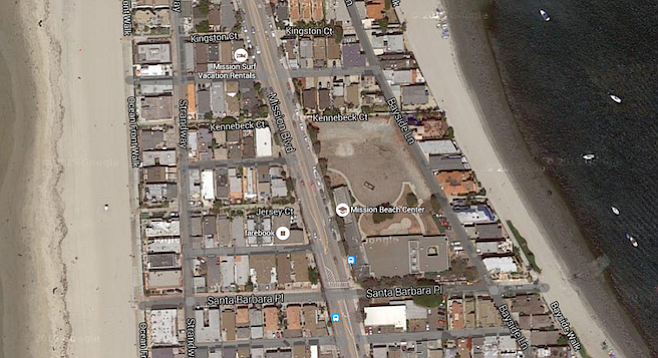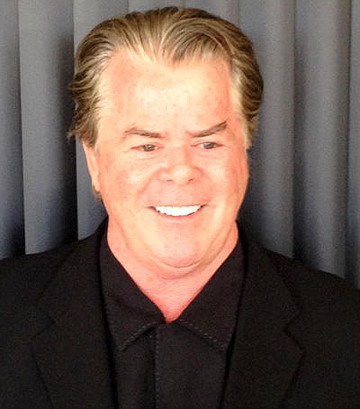 Facebook
Facebook
 X
X
 Instagram
Instagram
 TikTok
TikTok
 Youtube
Youtube

A divided San Diego City Council sided with the developers who proposed one project and then split it in two at the site of the former Mission Beach Elementary School Monday (April 11), shooting down the appeals of permits brought by the local planning group and town council.
The bigger part of the development will be between Kennebeck Court and Santa Barbara Place, east of Mission Bay Boulevard. The big bone of contention is a smaller project south of Santa Barbara.
Also in the project's crosshairs: a ficus tree that locals proclaim is historic and developers say could “fail” at any time.
The old elementary school was shuttered in 1997, and the San Diego Unified School District sold the property to the developer in 2013 for $18.5 million — over the objection of then-mayor Bob Filner, who wanted the land to remain public property.
More than 600 people have signed a petition to preserve the doomed tree — which would for residents preferably be at the center of a small park along Santa Barbara Place. More than 40 people showed up at the hearing to oppose the projects and advocate for saving the tree. Remarks were limited to one minute each.
In making their decision to deny residents' appeals, the council accepted a traffic study done in February and March that is supposed to represent the worst possible traffic conditions in the area and accepted the notion that the 63-home project is actually two projects — a 51-home project north of Santa Barbara Place and a 12-unit project south.
Loren Freestone, who lives near the old school, summed up the project like this: "We all know there was one piece of land sold, there is one architect, one engineering firm, one set of general plans, one EIR, one lobbyist and [they are] all under the control of one builder — there's even one online video for the whole project," Freestone said.

"Given these facts, they can't come before you and say these are two separate projects, at least not with a straight face."
But the builder and his team, lobbyist and former city development director Marcela Escobar-Eck, and the law firm of Allen Matkins did just that — and by putting the two separate projects on the council's agenda as two separate items, thwarted discussions of the effects of the larger project.
They successfully asserted that the land was zoned differently north and south of Santa Barbara and therefore required different processes.
In prevailing, the developers thwarted an attempt by residents to have more land set aside for a park within the project, the set-aside being calculated on the size of the project.

"The [California] Coastal Commission has written you telling you they have grave concerns over the bifurcation of the project," Freestone told the council.
But Tim McGowan, president of La Jolla developer McKellar-McGowan, pointed to what he called unanimous approval by the planning commission in March. And, he said, the arborist his company hired to look at the ficus, said it will fail.
"We believe the people who signed the petition were not aware of the danger," McGowan said.
The city council voted 5-2-1 on both projects, with Sherry Lightner and Todd Gloria opposing. Marti Emerald was absent.
(corrected 4/14, 12:00 p.m.)


A divided San Diego City Council sided with the developers who proposed one project and then split it in two at the site of the former Mission Beach Elementary School Monday (April 11), shooting down the appeals of permits brought by the local planning group and town council.
The bigger part of the development will be between Kennebeck Court and Santa Barbara Place, east of Mission Bay Boulevard. The big bone of contention is a smaller project south of Santa Barbara.
Also in the project's crosshairs: a ficus tree that locals proclaim is historic and developers say could “fail” at any time.
The old elementary school was shuttered in 1997, and the San Diego Unified School District sold the property to the developer in 2013 for $18.5 million — over the objection of then-mayor Bob Filner, who wanted the land to remain public property.
More than 600 people have signed a petition to preserve the doomed tree — which would for residents preferably be at the center of a small park along Santa Barbara Place. More than 40 people showed up at the hearing to oppose the projects and advocate for saving the tree. Remarks were limited to one minute each.
In making their decision to deny residents' appeals, the council accepted a traffic study done in February and March that is supposed to represent the worst possible traffic conditions in the area and accepted the notion that the 63-home project is actually two projects — a 51-home project north of Santa Barbara Place and a 12-unit project south.
Loren Freestone, who lives near the old school, summed up the project like this: "We all know there was one piece of land sold, there is one architect, one engineering firm, one set of general plans, one EIR, one lobbyist and [they are] all under the control of one builder — there's even one online video for the whole project," Freestone said.

"Given these facts, they can't come before you and say these are two separate projects, at least not with a straight face."
But the builder and his team, lobbyist and former city development director Marcela Escobar-Eck, and the law firm of Allen Matkins did just that — and by putting the two separate projects on the council's agenda as two separate items, thwarted discussions of the effects of the larger project.
They successfully asserted that the land was zoned differently north and south of Santa Barbara and therefore required different processes.
In prevailing, the developers thwarted an attempt by residents to have more land set aside for a park within the project, the set-aside being calculated on the size of the project.

"The [California] Coastal Commission has written you telling you they have grave concerns over the bifurcation of the project," Freestone told the council.
But Tim McGowan, president of La Jolla developer McKellar-McGowan, pointed to what he called unanimous approval by the planning commission in March. And, he said, the arborist his company hired to look at the ficus, said it will fail.
"We believe the people who signed the petition were not aware of the danger," McGowan said.
The city council voted 5-2-1 on both projects, with Sherry Lightner and Todd Gloria opposing. Marti Emerald was absent.
(corrected 4/14, 12:00 p.m.)
Comments